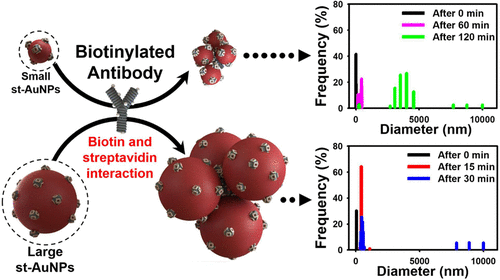当前位置:
X-MOL 学术
›
ACS Appl. Nano Mater.
›
论文详情
Our official English website, www.x-mol.net, welcomes your feedback! (Note: you will need to create a separate account there.)
Streptavidin-Coated Au Nanoparticles Coupled with Biotinylated Antibody-Based Bifunctional Linkers as Plasmon-Enhanced Immunobiosensors
ACS Applied Nano Materials ( IF 5.9 ) Pub Date : 2020-01-24 , DOI: 10.1021/acsanm.9b02461 Youngsang You 1 , Seokwon Lim 2 , Sundaram Gunasekaran 1
ACS Applied Nano Materials ( IF 5.9 ) Pub Date : 2020-01-24 , DOI: 10.1021/acsanm.9b02461 Youngsang You 1 , Seokwon Lim 2 , Sundaram Gunasekaran 1
Affiliation

|
The localized surface plasmon resonance (LSPR) effect of aggregating gold nanoparticles (AuNPs) has facilitated the development of colorimetric biosensors that can potentially be employed on site. We have developed an effective strategy to enhance the LSPR color-change signal by decoupling target detection and signal generation steps during immunobiosensing. The biosensor consists of streptavidin-coated AuNPs coupled with biotinylated antibacteria antibody as bifunctional linkers (BLs). While a BL can function both as an immunoreactor to bind to the target and as a cross-linker to aggregate AuNPs, its cross-linking function is largely limited when it binds with the target. We investigated the effect of number density (Dn) of AuNPs on the LSPR signal enhancement and the attendant improvement in detection sensitivity and rapidity of our biosensor by changing the particle size (5 to 50 nm diameter) when holding the absorbance of the AuNPs solution constant (Abs = 0.4 at 10× dilution). The performance enhancement of the biosensor was demonstrated by detecting a model target, streptavidin, and two bacteria, Escherichia coli and Legionella pneumophila. The results show that when Abs is held constant, the systems with lower Dn but larger particles perform better. Therefore, our visual biosensing system can be suitably composed to maximize the limit of detection and rapidity.
中文翻译:

链霉亲和素包被的金纳米粒子与生物素化的基于抗体的双功能接头偶联,作为等离子体增强的免疫生物传感器。
聚合金纳米颗粒(AuNPs)的局部表面等离子体共振(LSPR)效应促进了比色生物传感器的开发,该传感器可以在现场使用。我们已经开发了一种有效的策略,通过在免疫生物传感过程中将目标检测和信号生成步骤分离,来增强LSPR变色信号。该生物传感器由链霉亲和素包被的AuNP与生物素化抗菌素抗体作为双功能接头(BLs)组成。虽然BL既可以充当结合靶标的免疫反应剂,也可以充当聚集AuNPs的交联剂,但当它与靶标结合时,其交联功能受到很大限制。我们研究了数密度(D n)保持AuNPs溶液的吸光度恒定(在10倍稀释下,Abs = 0.4)时,通过改变粒径(直径为5至50 nm),可以提高LSPR信号增强AuNPs的灵敏度,并随之提高检测灵敏度和生物传感器的速度。通过检测模型目标链霉亲和素和两种细菌,即大肠杆菌和嗜肺军团菌,证明了生物传感器的性能增强。结果表明,当Abs保持恒定时,D n较低但颗粒较大的系统的性能更好。因此,我们的视觉生物传感系统可以适当地组成,以最大程度地提高检测速度和检测范围。
更新日期:2020-01-26
中文翻译:

链霉亲和素包被的金纳米粒子与生物素化的基于抗体的双功能接头偶联,作为等离子体增强的免疫生物传感器。
聚合金纳米颗粒(AuNPs)的局部表面等离子体共振(LSPR)效应促进了比色生物传感器的开发,该传感器可以在现场使用。我们已经开发了一种有效的策略,通过在免疫生物传感过程中将目标检测和信号生成步骤分离,来增强LSPR变色信号。该生物传感器由链霉亲和素包被的AuNP与生物素化抗菌素抗体作为双功能接头(BLs)组成。虽然BL既可以充当结合靶标的免疫反应剂,也可以充当聚集AuNPs的交联剂,但当它与靶标结合时,其交联功能受到很大限制。我们研究了数密度(D n)保持AuNPs溶液的吸光度恒定(在10倍稀释下,Abs = 0.4)时,通过改变粒径(直径为5至50 nm),可以提高LSPR信号增强AuNPs的灵敏度,并随之提高检测灵敏度和生物传感器的速度。通过检测模型目标链霉亲和素和两种细菌,即大肠杆菌和嗜肺军团菌,证明了生物传感器的性能增强。结果表明,当Abs保持恒定时,D n较低但颗粒较大的系统的性能更好。因此,我们的视觉生物传感系统可以适当地组成,以最大程度地提高检测速度和检测范围。



























 京公网安备 11010802027423号
京公网安备 11010802027423号